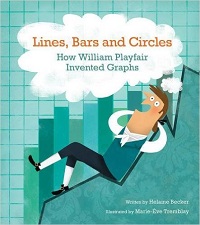| ________________
CM . . .
. Volume XXIII Number 30. . . .April 14, 2017
excerpt:
The title of this book hints at its two main themes. Lines, Bars and Circles: How William Playfair Invented Graphs is both the biography of an ambitious man, William Playfair, and a historical and mathematical look at the use of graphs to represent data in a compact and useful manner. This is a funny and appealing story of the life of an unusual man as well as a look at an entire historical period of scientific advancement. In some ways, this is an unexpected choice of topic as William did not succeed in having his ideas accepted in his lifetime, and he certainly had a number of character flaws. Perhaps this is part of what makes the book so engaging. Helaine Becker has written a complex story in clear and straightforward language with lots of humour and references to the 1700s, the stimulating historical period in which the three major types of graphs were first proposed and used. Science and inventing are presented as exciting activities contributing to the many ideas that were being developed, changing the world into the one that we know today. The three sidebars, on the Scientific Method, the Industrial Revolution and the French Revolution, expand on this aspect of the story. The sidebars can be omitted if the book is being read as a story or included if the point is to gather information about science and history. The final three pages also contain further, detailed information, including the original graphs that were published at that time. There is a nice balance between the story of the man and the ideas of graphing instead of presenting a table of data. Both are enticing, encouraging readers to go find more particulars about William Mayfair, the man, or a number of other inventors from the time, or about the Industrial Revolution. Marie-Ève Tremblay has perfectly matched the tone of the writing as the illustrations are also irresistibly humorous. For example, when the story says, “After a few years, though, Meikle’s workshop felt too small to hold all Will’s grand dreams”, the illustration shows Will lifting the roof of the house and stepping out into the world. The images in the biographical parts of the book emphasize the intimate world in which Will lived, and the more technical areas show some of the wonderful machines which are the very things that Will wanted to use to find fame and fortune. Even the graphs are shown in the same way. It is amusing to see William pushing one of the bars up to vertical in the bar graph and even more so to see him in his apron ready to slice the pie graph. Lines, Bars and Circles is a light hearted look at a single life, a historical period and the invention of graphical representations of data. It would be a valuable addition to a school library while being equally useful in a personal collection, succeeding both as a research tool and as a biographical story. Highly Recommended Willow Moonbeam is a librarian and former community college math professor living in Toronto, ON.
To comment
on this title or this review, send mail to cm@umanitoba.ca.
Copyright © the Manitoba Library Association. Reproduction for personal
use is permitted only if this copyright notice is maintained. Any
other reproduction is prohibited without permission.
Next Review | Table of Contents For This Issue - April 14, 2017 |
